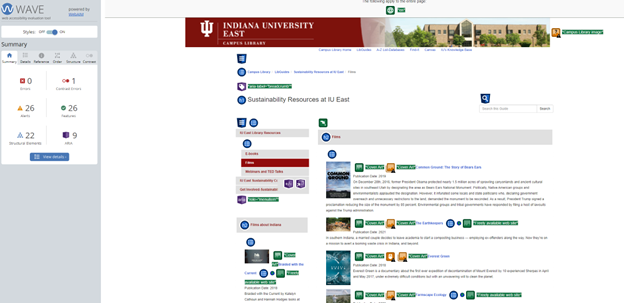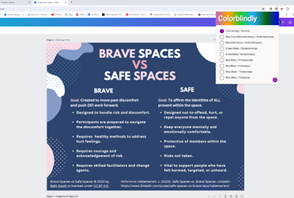This past summer, the Department of Justice released notice of proposed rulemaking for digital accessibility of state and local government entities that would require the adoption of Web Content Accessibility Guidelines (WCAG) version 2.1, Level AA as the technical standard for web content. This proposed rule is expected to take effect as early as summer of 2024, in which all Indiana University websites, digital content, and applications are expected to comply (although there are exceptions). Accessibility should be a concern for everyone involved in teaching and learning, not just web designers, learning technology consultants, or accessibility coordinators. If you are a content creator of any kind, whether student or faculty, you should check out our 2020 blog post on Accessibility for Online Content for things to consider.
It is a part of the IU East Campus Library mission to support all members of our teaching and learning community and to foster an inclusive environment and champion equitable access. Meeting accessibility standards is a vital part of that mission.
To comply with these efforts, the Campus Library has been reviewing library-controlled information and platforms and adjusting content to meet WCAG 2.1 standards, such as making sure our libguides feature high contrasting colors and appropriate headings and fonts, creating an accessibility policy and guidelines for our digital collections, and making sure our guides and blogs feature images with alternative text. We will also continue to monitor our vendors to ensure they also comply with WCAG 2.1 and train library staff on accessibility best practices when creating or archiving any digital content for public use or access. Indiana University offers many tools that can assist students and faculty in checking the accessibility of their web content.
- Siteimprove: is a web-based tool that crawls websites and reports back on
- quality assurance issues
- broken links and misspellings
- accessibility issues measured by the W3C Web Content and Accessibility Guidelines (WCAG).
Indiana University has obtained an enterprise license for Siteimprove. All official Indiana University departments, schools, and programs are encouraged to use it.
- Seven Simple Steps for Creating More Inclusive Digital Content: This Canvas Expand, self-paced course will introduce easy to learn techniques that handle most document accessibility concerns, make editing more efficient, and increase opportunities for how students engage with them.
- ADA Basics for Faculty: This Canvas Expand, self-paced course outlines your roles and responsibilities as an instructor under the Americans with Disabilities Act (ADA). It provides an overview of the accommodations process – when students make requests for support for their disabilities – and lists resources available to you during this process.
- Creating an Accessible Syllabus using Microsoft Word: This Canvas Expand, self-paced course walks you through creating a well-structured syllabus that can be accessible to all students.
There are also plenty of free resources, web browser extensions, and tools in applications that you can take advantage of to determine accessibility online, whether you are using Canva, WordPress, Pressbooks, Canvas, or any other website platform.
Browser Extensions:
- WAVE: WAVE Chrome, Firefox, and Edge browser extensions are available for testing accessibility directly within your web browser – handy for checking password protected, locally stored, or highly dynamic pages. When you click on the extension tool, an accessibility summary will pop up on the left side of the webpage and you can view the details of the report and correct the features it identifies as errors.
- Colorblindly: This is a Chrome extension that helps developers and designers simulate different types of color blindness:
- Blue Cone Monochromacy
- Achromatomaly-Monochromacy
- Achromatopsia-Green-Weak
- Deuteranomaly-Green-Blind
- Deuteranopia-Red-Weak
- Protanomaly-Red-Blind
- Protanopia-Blue-Weak
- Tritanomaly-Blue-Blind
- Tritanopia
This extension tool opens in the top right corner, and you just select the different simulations to see how the colors or images you’re using look to someone with that disability.
Authoring Tools:
It is also good practice to use the accessibility checker when creating Microsoft documents, PowerPoint slides, Excel documents, or Adobe PDF’s. Many of these documents can be posted or shared online, so it is important to ensure that these documents are also accessible. We recommend reading this short chapter, Document Accessibility for Screen Readers, to understand how screen readers work and best practices for document or webpage layouts. As many will tell you, this work benefits everyone, not just those who may have a disability, and it is easier to make a document accessible from the start, so keep these tips and tools in mind when starting any new creation.
Resources:
This blog focuses specifically on accessibility of digital content, which leans more into assisting visual or audio needs. However, accessibility efforts may also include accommodating mental, physical, or emotional disabilities. For more information on this topic, check out the following library resources:
- Accessibility and diversity in education: breakthroughs in research and practice
- Enhancing higher education accessibility through open education and prior learning
- Accessibility denied: Understanding inaccessibility and everyday resistance to inclusion for persons with disabilities
- Our multidisciplinary databases, ProQuest Central and Academic Search Complete, are also great resources to locate research-based articles on topics related to accessibility and disabilities.
If you have any questions about this topic, or have any accessibility barriers to our library content, contact us at liblearn@iue.edu.




